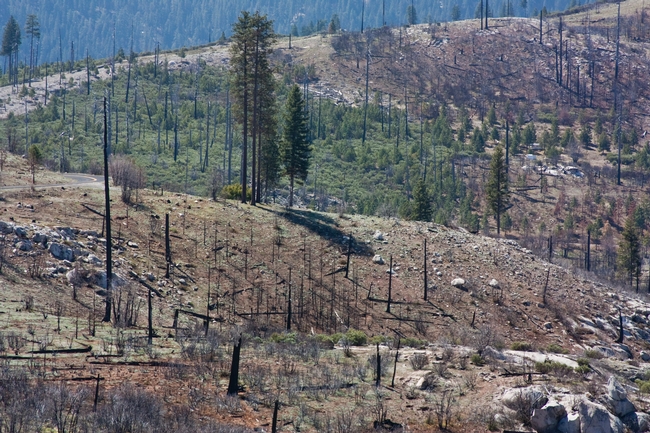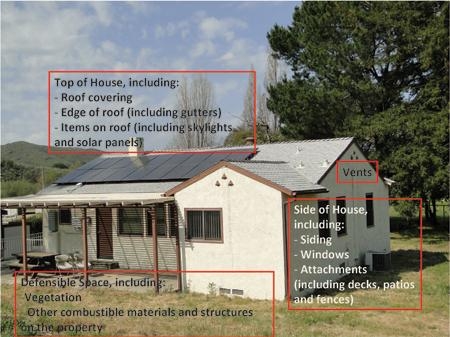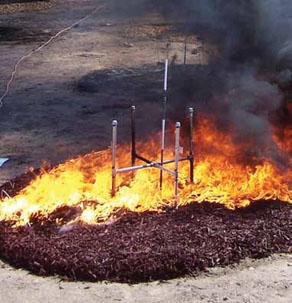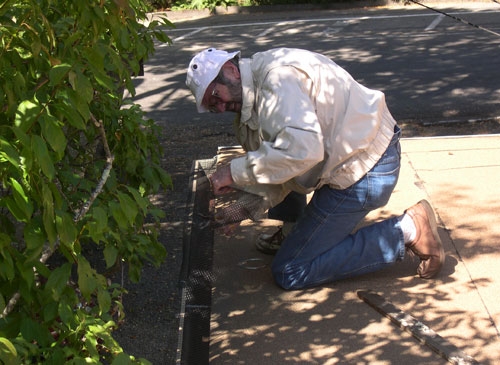Posts Tagged: wildfire
Solve economy, wildfires woes at same time
Forest restoration would be one way to improve our economy, writes researcher Tong Wu of the Center for Forestry and UC Berkeley on CNN's Global Public Square news website. He states that human interference has "made many ecosystems unnaturally susceptible to catastrophic wildfires" and that global warming will exacerbate the problem.
"In economic analyses of environmental management projects across the western United States, ecological restoration produced multiplier effects (the economic 'bang for the buck' of every dollar spent) that were higher than the estimated impacts of the 2009 government stimulus," he wrote.
It only takes a spark
The Las Conchas fire that recently consumed nearly 137,000 acres in Los Alamos, N.M., serves as a reminder of how quickly fire can move if given fuel. I can’t light a barbecue with matches and lighter fluid, but a small ember drifting on the wind can find so many ways to burn down people’s homes if given the right conditions.
Removal of vegetation near Los Alamos National Laboratory, which is part of the UC system, created a buffer and helped spare the lab from the Las Conchas fire, which came within 50 feet. Creating a buffer is one of many preventive measures that can be taken to protect property from wildfires.
In a wildfire-prone area, even if you have a house with a concrete tile roof and noncombustible siding, an ember landing on landscape mulch, igniting plants around the home or floating into a vent on the house or under decks may set the house ablaze, warns a UC Cooperative Extension fire expert.
“From years of observing the aftermath of fires and testing fire-resistant building materials, we have developed a much better understanding about what happens,” says Steve Quarles, UC Cooperative Extension wood performance and durability advisor.
Quarles lists six priority areas for evaluating the vulnerability of homes in fire hazard zones: the roof, vents, landscape plants, windows, decking and siding. For details on how you can reduce the threat of wildfire to your home, visit Quarles' Homeowner's Wildfire Mitigation Guide.
“We know that the zone within about five feet of the home is very important to home survival during a wildfire,” Quarles says.
Landscape mulch provides many benefits to a garden, but Quarles and his colleague Ed Smith, University of Nevada Cooperative Extension natural resource specialist, found that many types of mulch are capable of catching fire and burning. Within five feet of a house, they recommend placing only rock, pavers, brick chips or well-irrigated, low-combustible plants such as lawn or flowers.
Quarles and Smith have published a new manual comparing the relative susceptibility of eight mulch treatments to igniting and burning. To download a free copy of “The Combustibility of Landscape Mulches,” visit the UC Fire Center website.
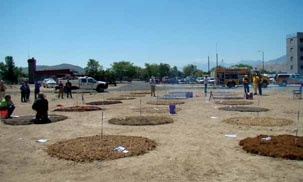
The scientists tested eight types of landscape mulches, shown in this test plot.
Consider fire risk when planning improvements
Most people planning home improvement projects take into account how improvements will affect the home’s ability to withstand rain and weathering. We should also consider the threat of wildfire when planning home improvement projects this spring.
Most homes that burn during wildfires are ignited by flying embers landing on combustible material on or near homes. A wildfire passes by a home quickly, usually in a few minutes, while the exposure to flying embers can last for an hour or more. Therefore, activities homeowners undertake to make their home less ignitable from embers do the most to ensure its survival.
The most important home upgrade homeowners can do to reduce wildfire risk is to replace wood shake roofs with Class A roofs. Single-paned windows should also be replaced with dual-pane windows (with at least one pane being tempered). Combustible siding can also be vulnerable, but replacing it with non-combustible siding is less important if you have done a good job of locating and maintaining vegetation near your home. Replacing combustible decks with noncombustible decking products will also reduce risk.
Even though these upgrades are expensive, they reduce the likelihood that you will experience the cost and trauma of losing a home in a wildfire. If you cannot afford to undertake these projects this year, there are less expensive projects you can take on to reduce wildfire risk. These center on maintaining your home in good condition by replacing worn boards , sealing cracks in locations where embers can enter the home, and protecting vulnerable areas with non-combustible materials and coverings.
Even if you have already upgraded your home to resist fire by installing a new roof, windows, or deck, it is important to maintain those home components in their proper condition so embers cannot gain entrance to the home. Creating defensible space by clearning flammable vegetation and debris is also crucial to reducing your wildfire risk. For more information on the performance of building materials in a wildfire, please see http://firecenter.berkeley.edu/ or www.extension.org/surviving_wildfire. For more on creation of defensible space, contact your local fire agency and see www.livingwithfire.info/tahoe.
Suggested home maintenance projects to reduce wildfire risk
Roof:
- Plug roof openings: Install end-stops (bird-stops) at the edge of your roof if it has a gap between the roof and the sheathing (as with a clay barrel tile roof).
- Protect roof edges: Install metal angle flashing at the roof edge to protect the roof sheathing and fascia board, especially if there are gutters attached that can hold combustible pine needles. Even a Class A roof cannot protect the wood sheathing under it if the roof edge is unprotected.
- Protect roof eaves: “Box in” your open eaves with sheathing, such as a fiber cement soffit or higher grade plywood.
- Skylights: Particularly on steep or flat roofs, replace plastic skylights with skylights that use tempered glass in the outer pane.
Siding:
- Maintain siding: Fill gaps in siding and trim materials with a qood quality caulk help keep out embers. Replace warped or degraded siding.
Vents:
- Protect vents: Inspect the vents into your attic and crawl space. Make sure the screens are in good condition. Replace ¼ inch mesh screen with 1/8 inch mesh screening.
Decks:
- Maintain decks: Replace deck boards that are less than an inch thick with two inch thick boards. Remove combustible materials from under the deck.
- Protect combustible siding: Install metal flashing between a deck and combustible siding to protect it from accumulated debris that can ignite during ember attack.
- Remove flammable material from under decks: If your deck is made from wood or wood-plastic lumber decking, remove combustibles (firewood, lumber, etc.) from under the deck.
Fence:
- Replace gates: Replace combustible gates and sections of wooden fences within five feet of the house with noncombustible materials and components.
Garage:
- Adjust garage doors: Your garage door can be very “leaky” to embers. Since most people store combustibles in their garage, make sure your garage door is well sealed at the edges.
Steve Quarles takes job with insurance institute
The Insurance Institute for Business and Home Safety announced last week that Stephen Quarles will join the IBHS research team as senior scientist - hurricane/high-wind building durability and fire protection.
He will also occupy the South Carolina Wind and Hail Underwriting Association Hazard Resilience Chair at the IBHS Research Center.
Quarles has been a wood durability advisor for UC Cooperative Extension since 2000.
“Although my years with UC Cooperative Extension were very rewarding, I could not pass up the opportunity to work for IBHS and in particular at the Research Center with its scientists and staff," Quarles was quoted in the news release. "I am excited to have a more direct role in IBHS research and outreach activities that will help improve the durability of our new and existing buildings.”
Quarles has a bachelor's degree in forestry from Virginia Tech, and master's and doctorate degrees in forest products from the University of Minnesota. He is co-chair of the eXtension Wildfire Information Network (eWIN) Community of Practice, and is a member of the Society of Wood Science and Technology, the Forest Products Society, American Society of Testing and Materials, American Wood Protection Association, the National Fire Protection Association, and the Association of Natural Resource Extension Professionals.
“Steve brings a wealth of experience in the areas of wood durability, aging, water penetration, and wildfire - all critical aspects of our field and laboratory research programs," the release quoted Julie Rochman, IBHS president and CEO. “We have long admired Steve's meticulous, incredibly smart work, and look forward to having him add new dimensions to our already impressive group of property loss mitigation experts.”
Quarles begins his new position Aug. 1.
Protecting a home from wildfire for $20 or less
There are many things homeowners can do to protect their homes from wildfire that cost $20 or less, said the Insurance Institute for Business and Home Safety in a news release distributed yesterday.
The article suggests undertaking low-cost, simple but important safety steps like clearing gutters, sealing around doors and covering vents.
Last month, the organization conducted the first-ever full-scale wildfire demonstration at its South Carolina research center. The demonstration was part of a building science initiative designed to illustrate how easily some commonly used materials and items near or on houses can ignite from embers, and what homeowners can do to better protect their homes.
“Most people believe that it is the advancing line of flames during a wildfire that destroys homes,” IBHS president was quoted in the story. “Rather, it is embers or firebrands that create spot fires by igniting vegetation, debris and flammable materials that lead to ignition of the exterior of a house, as well as embers blown or drawn into buildings through gable vents, soffit vents and other openings that can ignite a house from the inside. And our laboratory test vividly demonstrated just that.”
The article credited UC Cooperative Extension for contributing to its list of suggestions for improving a home's chances of survival when a wildfire threatens. The suggestions include:
- Ensure the home has a Class A rated roof.
- Maintain a carefully managed and maintained vegetation zone within a five-foot zone adjacent to the home.
- When a wildfire is threatening, close the windows.
- Clean debris out of rain gutters.
- Install end-stops (bird-stops) at the edge of the roof if there are gaps.
- Do not store combustible items, such as firewood and lumber, under the deck.
- Keep all gaps clear of vegetative debris or cover gaps with metal siding.
- Make sure the garage door is well sealed at the edges.
UC Cooperative Extension wood durability advisor Stephen Quarles has developed an online Homeowner's Wildfire Mitigation Guide with detailed instructions for making changes to a home and its surroundings to reduce the possibility of damage from wildfires.
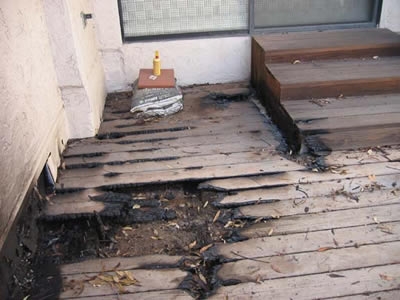
This deck had debris in the board gaps that caught fire.


